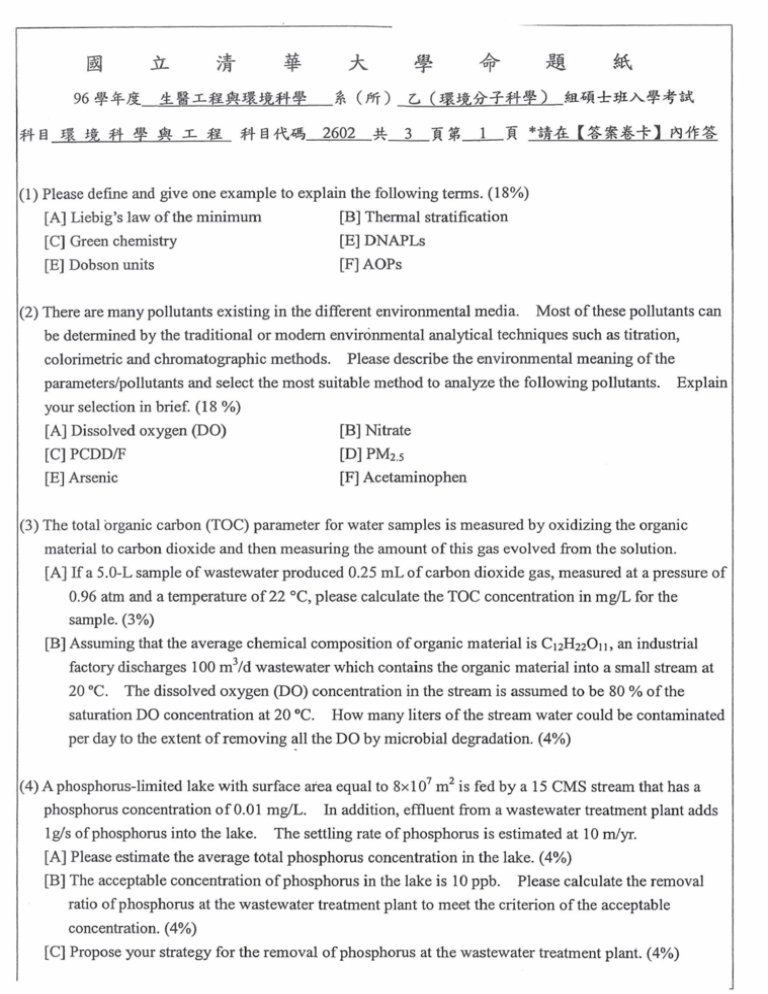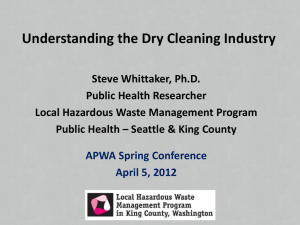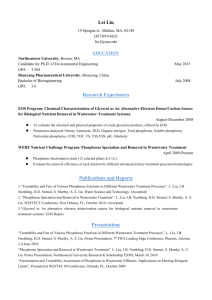1) Please define and give one example to explain the following terms.
advertisement

1) Please define and give one example to explain the following terms. (18%) [A] Liebig's law of the minimum [B] Thermal stratification [C] Green chemistry [El DNAPLs [El Dobson units [F] AOPs 2) There are many pollutants existing in the different environmental media. Most of these pollutants can be determined by the traditional or modern environmental analytical techniques such as titration, colorimetric and chromatographic methods. Please describe the environmental meaning of the pararneters/pollutants and select the most suitable method to analyze the following pollutants. Explain your selection in brief. (18 %) [B] Nitrate [A] Dissolved oxygen (DO) [C] PCDDE [Dl PM2.5 [F] Acetaminophen [El Arsenic 3) The total organic carbon (TOC) parameter for water samples is measured by oxidizing the organic material to carbon dioxide and then measuring the amount of this gas evolved from the solution. [A] Ifa 5.0-L sample of wastewater produced 0.25 mL of carbon dioxide gas, measured at a pressure of 0.96 atm and a temperature of 22 "C, please calculate the TOC concentration in mg/L for the sample. (3%) [B] Assuming that the average chemical composition of organic material is C12H2201 1, an industrial factory discharges 100 m3/d wastewater which contains the organic material into a small stream at 20 "C. The dissolved oxygen (DO) concentration in the stream is assumed to be 80 % of the saturation DO concentration at 20 "C. How many liters of the stream water could be contaminated per day to the extent of removing all the DO by microbial degradation. (4%) 4) A phosphorus-limited lake with surface afea equal to 8x107 m2 is fed by a 15 CMS stream that has a phosphorus concentration of 0.0 1 mg/L. In addition, effluent from a wastewater treatment plant adds lg/s of phosphorus into the lake. The settling rate of phosphorus is estimated at 10 dyr. [A] Please estimate the average total phosphorus concentration in the lake. (4%) [B] The acceptable concentration of phosphorus in the lake is 10 ppb. Please calculate the removal ratio of phosphorus at the wastewater treatment plant to meet the criterion of the acceptable concentration. (4%) [C] Propose your strategy for the removal of phosphorus at the wastewater treatment plant. (4%) a 3~ :la* 8 96 ++& Y %=B&%+R?l-+ % ) H a % % # r l $ $ t x %?l-H4%@5 q A 2602 9 Bi >% z (q!i$WT?l-$)$a%&.Ftfhc$+% 3 2 X **&[%$%-f.]fl6S (5) Please identify the possible fate and transport of particulates and gaseous pollutants in the atmosphere. In addition, please tabulate the control technology and possible removal efficiencies for particulates and gaseous pollutants in the atmosphere. (10%) (6) Given that 100 tonlh of commingled MSW which contains 8% glass are supplied to a trommel screen for the removal of glass prior to incineration. [A] Please determine the recovery, purity and efficiency of the screen based on the following experimental data. (5%) Weight of underflow = 10 tonlh Weight of glass in screen underflow = 7.2 ton/h [B] Assume that the composition of MSW is CsoH100040N, please determine the air requirement (expressed in kglton) for incinerating the MSW. (5%) (7) Polycyclic aromatic hydrocarbons (PAHs) are a class of compound produced from the incomplete combustion. Recent research has established that PAH themselves are not carcinogenic; rather some of their biotransfomation products are cancer-causing species. The relative positions in space of the fused rings in PAHs are believed to play a major role in determining their level of carcinogenic behaviors. Usually the PAHs that are the most potent carcinogens each posses a bay region formed by the branching in the benzene ring sequence. According to this statement, please indicate the potent carcinogens shown below and explain your reasons. (5%) &@ / \ / / / / / . / / / / / (8) An underground tank, which contains benzene, toluene, ethylbenzene and xylene (BTEX) and tetrachloroethylene (PCE), has been leakage for many years. After sampling and analysis, concentrations of BTEX and PCE in groundwater directly beneath the contaminated site are 3.5,5.8,0.6 and 6.5 mg/L for BTEX and 0.2 mg/L for PCE, respectively. The contamination is flowing at a rate of 0.5 mlday toward a public drinking well 100 m away. Please answer the following questions according to the data shown below: a + % : /a 96 *ql!€ iL%~B&%%#$% f #a 3%&#@ .BF L $ Z HafiG5 B *% L (5$i+k&T#9) .4;d%**hq%H i 2602 & 3 R3i$ 3 R *~&[S%%+l Toluene Ethylbenzene Xylene NA NA NA NA 0.3 0.1 0.3 0.01 (mg/kg-d) 15 Half life (day) NA:not avsllrablc---------------- 20 60 25 150 Compounds parameters Slope factor (mg&?-d)-' Reference dose -------. Q 4F A Benzene 2.9 x PCE 5.1~10~~ -------- [A] Please findthe residual concentrations of BTEX and PCE in drinking well. (3%) [B] Find the upper-bound cancer risk and potential hazard index (HI) for this contaminated groundwater when a 70-kg person drinks 2L of this water per day for 10 years. (4%) [C] Is the contaminated water harmful to human beings if the acceptable cancer risk is Please propose your strategy to reduce the risk if it is harmful. (3%) - (9) Pollution prevention is one of the most important strategies for the minimization of wastes from industries. One technique used in pollution prevention isthe Life Cycle Assessment (LCA), which is an accounting of all the inputs and outputs in the various steps of a product's life. This "cradle-to-grave" analysis for a product can be used to identify the types and magnitudes of environmental impacts that the product makes. [A] Please briefly describe the basic steps of LCA. (4%) [B]Please generate lists of the aspects of production, distribution and disposal for glass bottles and aluminum cans that you would employed in a life cycle assessment for the purpose of deciding which is the more environmentally friendly container for beer. (6%) ----------------- 7








